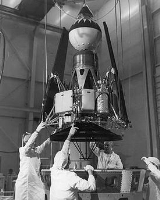
Ranger 4
Encyclopedia
EWLINE
|
||||||
Ranger 4 was a spacecraft of the Ranger program
Ranger program
The Ranger program was a series of unmanned space missions by the United States in the 1960s whose objective was to obtain the first close-up images of the surface of the Moon. The Ranger spacecraft were designed to take images of the lunar surface, returning those images until they were destroyed...
designed to transmit pictures of the lunar surface to Earth
Earth
Earth is the third planet from the Sun, and the densest and fifth-largest of the eight planets in the Solar System. It is also the largest of the Solar System's four terrestrial planets...
stations during a period of 10 minutes of flight prior to crashing upon the Moon
Moon
The Moon is Earth's only known natural satellite,There are a number of near-Earth asteroids including 3753 Cruithne that are co-orbital with Earth: their orbits bring them close to Earth for periods of time but then alter in the long term . These are quasi-satellites and not true moons. For more...
, to rough-land a seismometer
Seismometer
Seismometers are instruments that measure motions of the ground, including those of seismic waves generated by earthquakes, volcanic eruptions, and other seismic sources...
capsule on the Moon, to collect gamma-ray data in flight, to study radar reflectivity of the lunar surface, and to continue testing of the Ranger program for development of lunar and interplanetary spacecraft. An onboard computer failure caused failure of the deployment of the solar panel
Photovoltaic module
A solar panel is a packaged, connected assembly of solar cells, also known as photovoltaic cells...
s and navigation systems; as a result the spacecraft crashed on the far side of the Moon without returning any scientific data.
Spacecraft design
Ranger 4 was a Block II Ranger spacecraft virtually identical to Ranger 3Ranger 3
Ranger 3 is a spacecraft of the Ranger program that was launched to study the Moon on January 26, 1962. The space probe was designed to transmit pictures of the lunar surface to Earth stations during a period of 10 minutes of flight prior to impacting on the Moon, to rough-land a seismometer...
. The basic vehicle was 331 kg, 3.1 m high and consisted of a lunar capsule covered with a balsawood impact-limiter, 650 mm in diameter, a mono-propellant mid-course motor, a 5080 lbf (22.6 kN) thrust retrorocket, and a gold- and chrome-plated hexagonal base 1.5 m in diameter. A large high-gain dish antenna was attached to the base. Two wing-like solar panels (5.2 m across) were attached to the base and deployed early in the flight. Power was generated by 8680 solar cells contained in the solar panels which charged an 11.5 kg 1 kWh capacity AgZn launching and backup battery. Spacecraft control was provided by a solid-state computer and sequencer and an earth-controlled command system. Attitude control was provided by Sun and Earth sensors, gyroscopes, and pitch and roll jets. The telemetry system aboard the spacecraft consisted of two 960 MHz transmitters, one at 3 W power output and the other at 50 mW power output, the high-gain antenna, and an omni-directional antenna. White paint, gold and chrome plating, and a silvered plastic sheet encasing the retrorocket furnished thermal control.
The experimental apparatus included: (1) a vidicon television camera, which employed a scan mechanism that yielded one complete frame in 10 s; (2) a gamma-ray spectrometer mounted on a 1.8 m boom; (3) a radar altimeter; and (4) a seismometer to be rough-landed on the lunar surface. The seismometer was encased in the lunar capsule along with an amplifier, a 50-milliwatt transmitter, voltage control, a turnstile antenna
Turnstile antenna
A turnstile antenna is a set of two dipole antennas aligned at right angles to each other and fed 90 degrees out-of-phase. The name reflects that the antenna looks like a turnstile when mounted horizontally. When mounted horizontally the antenna is nearly omnidirectional on the horizontal plane...
, and 6 silver-cadmium batteries capable of operating the lunar capsule transmitter for 30 days, all designed to land on the Moon at 130 to 160 km/h (80 to 100 mph). The radar altimeter would be used for reflectivity studies, but was also designed to initiate capsule separation and ignite the retro-rocket.
Mission
The mission was designed to be boosted towards the Moon by an Atlas/Agena, undergo one mid-course correction, and impact the lunar surface. At the appropriate altitude, a smaller capsule was to separate and the retrorockets ignite to cushion the landing. Due to an apparent failure of a timer in the spacecraft's central computer and sequencer following launch the command signals for the extension of the solar panels and the operation of the sun and earth acquisition system were never given. The instrumentation ceased operation after about 10 hours of flight. The spacecraft was tracked by the battery-powered 50 milliwatt transmitter in the lunar landing capsule. Ranger 4 crashed upon the far side of the Moon at 9600 km/h at 12:49:53 UT on April 26, 1962 after 64 hours of flight.This spacecraft, similar in design to Ranger 3, was the first U.S. spacecraft to
reach another celestial body. A power failure in the central computer and sequencer stopped the spacecraft’s master clock and prevented the vehicle from performing any of its preplanned operations, such as opening its solar panels. Drifting aimlessly and without any midcourse corrections, Ranger 4 crashed upon the far side of the Moon at 12:49:53 UT on 26 April 1962. Impact coordinates were 15°30' south latitude and 130°42' west longitude. Although the spacecraft did not achieve its primary objective, the Atlas-Agena-Ranger combination performed without fault for the first time.
External links
- Lunar impact: A history of Project Ranger (PDF) 1977
- Reuters.com, Planned lunar missions
- Reuters.com, Chronology - Five key dates in the race to the moon

